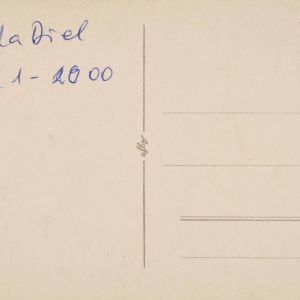ST. Mary's Square
The St. Mary's Monument was built on the place where, according to the legend, Gheorghe Doja was executed, in 1514.
Listen to the audio version.
The monument dedicated to the Blessed Virgin Mary in St. Mary's Square was consecrated in December 1906 by Bishop József Németh, on the place where it was believed that Gheorghe Doja, the leader of the peasant uprising of the 16 century, was executed by coronation with a hot crown.
According to tradition, in the moments when Ghe. Doja was subjected to torment, in 1514, the Franciscan monks present at the execution, who sang religious hymns, would have seen in the sky the face of the Virgin Mary. After Doja's martyrdom, an icon of the Virgin was built on that place, the location being frequented by pilgrims and included in the religious processions organized by the Catholic Church.In the first half of the 19th century, a wooden statue was placed in the place of the old icon, but this was also replaced, in 1865, by a statue made of Bavarian stone. Twelve years later, in 1877, the Catholic nuns from Timișoara-Cetate raised at their own expense a new statue of the Virgin Mary, brought from the Mayer-Munich Institute in Bavaria.
The current monument, built according to the plans of the architect László Székely, was made at the request of the inhabitants, with the involvement of the priest David Lang, by initiating a collection by the city.
The statue of the Virgin Mary, made of Carrara marble and sculpted by the artist György Kiss, is surrounded by a structure based on 8 columns of Belgian granite, connected by 4 arches in the center, in 4 directions. A sum of 23,000 crowns was paid for the construction of this eclectic architectural ensemble, in the 1900s style, which intertwines Romanesque and Byzantine elements. Responsible for the landscaping around the monument is the landscape architect Franz Niemetz, who arranged the space at his own expense.
On the wall behind the chapel there is still an inscription in Hungarian: “To the Mother of God, to the Protector […] / on the place of the cruel death of Gheorghe Doja († 1514) / preserved by the tradition of the centuries /offers to pious reconciliation/ this monument / The city of Timișoara and its inhabitants/ 1906 ”.
Bibliography:
1. Josef Geml, Vechea Timișoară în ultima jumătate de secol 1870-1920, Cosmopolitan Art Publishing House, Timișoara, 2016, p. 116.
2. Deselega Gyula, Ghidul Timișoarei, Fundația Diaspora, Timișoara, 2011, pp. 166-167.
3. János Szekernyés, Semne evocatoare ale maghiarimii în Banat, Timișoara, 2013, pp. 591-592.
4. Nicolae Ilieșiu, Timișoara. Historical Monograph, vol. I, Editura G. Matheiu, Timișoara, 1943, p. 345.
5. Mihai Opriș, Mihai Botescu, Historical Architecture in Timișoara, ed. Tempus, 2014
Listen to the audio version.
Pia Brînzeu, Family Journal, Manuscript
Stop 1: The St. Mary Monument in Maria Square
March 19, 1961 There is turmoil in our home. A director from the Ministry has visited the hospital where Father works and declared that he finds it boring to have dinner all by himself. Father felt obliged to invite him over to our house and he was going to come accompanied by two other comrades. Secret police officers, Communists, who knows? The problem is our dining room is not too suitable for this type of invitation. Grandmother brought it from Austria when she married Grandfather and it is typical of the Tyrolese world she had lived in. What this means is that it has around the table, in the corner, a wooden bench, with a high back that goes all the way up to the ceiling, on which tin pots and plates are displayed, and in the middle, where the two wooden panels meet, there is a big crucifix. Its presence is mandatory. You can find it, with no exception, in all the dining rooms from the Austrian and Swiss Alps.
Leaning over those having their meals, our Christ has shared in all the lunches and dinners organised underneath him throughout the years, a silent witness of the struggles of history and of our own family, from the Banat’s integration in the Greater Romania to the Second World War and the instauration of Communism, from my mother’s birth to my childhood, from the making and unmaking of fortunes to the invasion of the three families of tenants, who now pass through our rooms to go to work or to the bathroom. To Grandmother’s great joy, the tenants have also reached the basement: if they hadn’t occupied the lower rooms, she kept on repeating, it would have been us who would have ended up living there, as it happened with other rich homeowners in our city.
Well, this crucifix has to go now, at all cost, but Grandmother cannot possibly agree. She demands firmly: the comrades should not come! Father is desperate because he cannot cancel the invitation, and Mother is going back and forth unsuccessfully between a tearful grandmother and an angry father. I’ve hidden with a book in hand, pretending I had to study for school, but I am observing the scene carefully. I know Father will eventually win – he is the man of the house, after all, and nobody can oppose him too much. Or is allowed to. Or it’s not proper to oppose him, since that is the way women from my mother’s and my grandmother’s generation think. Housewives depend on their husbands and cannot contradict them too easily, and forceful Feminism has not reached us yet.
“Can’t you see Jesus is still alive up there, on the Cross? Can’t you see He is still breathing? If we take Him down, He will die completely”.
I know what is bothering her. In my grandmother’s mind, the breath of the crucified connects to the journey of the migrant, of the person who, once they’ve left behind their place of origin and become an Ausländer, sees the crossing from one country into another like the act of inhaling/exhaling. Grandmother has lost her roots; she is now living in another world, surrounded by other languages than those of back home. Looking at the crucifix and at the wood’s breath she feels the life of the Tyrolese fir tree on a mountain top, she feels getting in and out of her body another kind of air than that of the Banat steppe, which is un-cool and devouring. And breathing, air, the flight of the vital breath mean salvation. Only thus do the powers of the sky wrap around the soul who has now become the prisoner of another geography. One can rise as high up in the air as one wants; it hides you like a box of photographs and relates to memory, to the archive, to the past. The air contains the mystery of the unseen, and when one hides things up in the air one can perpetuate one’s belonging to one’s nation, one can stay connected to a point of origin and can create an accurate world axis. Our crucifix sings in the air of the room, Grandmother says, and its breath represents real life. But Grandmother also knows how many people got arrested for their beliefs. Even Grandfather Brînzeu has spent five years far away from his family. Bad things happen fast when you are too stubborn.
The crucifix remained in a basement room for a few decades. It still protected us from down there with its breath, and when it got back to its place on the wall, it smiled at us understandingly: it knew it could not escape the turmoil of history but it knew just as well that, eventually, it could not possibly be harmed. No matter how many atheists would come to dinner, the Tyrolese wood will keep on living through the discrete beauty of its shapes and hues.

Artwork by Tania Tomici, student in 9th grade "Grigore Moisil" Theoretical High School in Timișoara and exposed to UPT Library within the exhibition "Timisoara's Stories - A visual journey through Timisoara" - within the Project Creative Schools - Timisoara Stories - a continuation of the Spotlight Heritage Timisoara project, part of the cultural program of Timisoara Cultural Capital 2023 - project that brought together over 1600 children and teenagers and more than 60 teachers from Timisoara's schools, in over 50 interactive activities.









